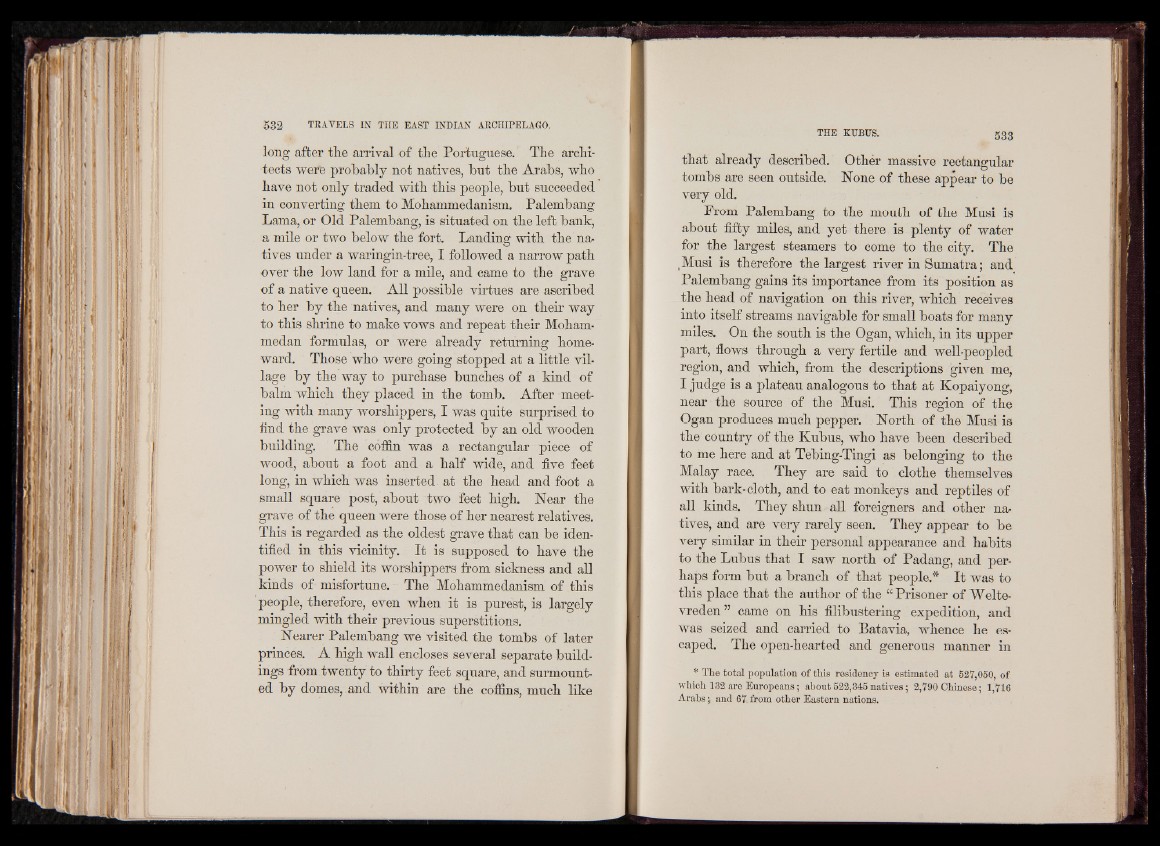
long after the arrival of tlie Portuguese. The architects
weife probably not natives, but the Arabs, who
have not only traded with this people, but succeeded
in converting them to Mohammedanism. Palembang
Lama, or Old Palembang, is situated on the left bank,
a mile or two below the fort. Landing with the natives
under a waringin-tree, I followed a narrow path
over the low land for a mile, and came to the grave
of a native queen. All possible virtues are ascribed
to her by the natives, and many were on their way
to this shrine to make vows and repeat their Mohammedan
formulas, or were already returning homeward.
Those who were going stopped at a little village
by the way to purchase bunches of a kind of
balm which they placed in the tomb. After meeting
with many worshippers, I was quite surprised to
find the grave was only protected by an old wooden
building. The coffin was a rectangular piece of
wood, about a foot and a half wide, and five feet
long, in which was inserted at the head and foot a
small square post, about two feet high. Near the
grave of the queen were those of her nearest relatives.
This is regarded as the oldest grave that can be identified
in this vicinity. It is supposed to have the
power to shield its worshippers from sickness and all
kinds of misfortune. The Mohammedanism of this
people, therefore, even when it is purest, is largely
mingled with their previous superstitions.
Nearer Palembang we visited the tombs of later
princes. A high wall encloses several separate buildings
from.twenty to thirty feet square, and surmounted
by domes, and within are the coffins, much like
that already described. Other massive rectangular
tombs are seen outside. None of these appear to be
very old.
From Palembang to the mouth of the Musi is
about fifty miles, and yet there is plenty of water
for the largest steamers to come to the city. The
(Musi is therefore the largest river in Sumatra; and
Palembang gains its importance from its position as
the head of navigation on this river, which receives
into itself streams navigable for small boats for many
miles. On the south is the Ogan, which, in its upper
part, flows through a very fertile and well-peopled
region, and which, from the descriptions given me,
I judge is a plateau analogous to that at Kopaiyong,
near the source of the Musi. This region of the
Ogan produces much pepper. North of the Musi is
the country of the Kubus, who have been described
to me here and at Tebing-Tingi as belonging to the
Malay race. They are said to clothe themselves
with bark-cloth, and to eat monkeys and reptiles of
all kinds. They shun all foreigners and other natives,
and are very rarely seen. They appear to be
very similar in their personal appearance and habits
to the Lubus that I saw north of Padang, and perhaps
form but a branch of that people.* It was to
this place that the author of the “Prisoner of Welte-
vreden” came on his filibustering expedition, and
was seized and carried to Batavia, whence he escaped.
The open-hearted and generous manner in
* The total population of this residency is estimated at 527,050, of
which 132 are Europeans; about 522,345 natives; 2,790 Chinese; 1,716
Arabs; and 67 from other Eastern nations.